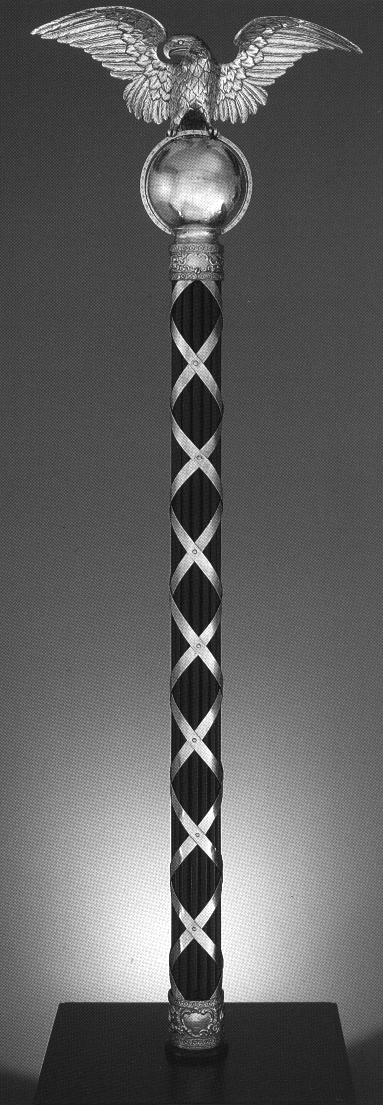The Mace of the House of Representatives
 The Mace used by the United States House of Representatives is one of the most
cherished possessions of the House. It is also one of the oldest and most important symbols
of our nation’s government. Combining the form of the Roman fasces with that of the mace
used by the British House of Commons, the Mace of the United States House of
Representatives is a visible reminder that our national legislature has roots in the traditions of
the Roman Republic and the British Parliament.
The Mace used by the United States House of Representatives is one of the most
cherished possessions of the House. It is also one of the oldest and most important symbols
of our nation’s government. Combining the form of the Roman fasces with that of the mace
used by the British House of Commons, the Mace of the United States House of
Representatives is a visible reminder that our national legislature has roots in the traditions of
the Roman Republic and the British Parliament.
On April 14, 1789, in one of its first resolutions, the House of Representatives of the First
Federal Congress established the Office of the Sergeant at Arms. The first Speaker of the
House, Frederick Muhlenburg of Pennsylvania, approved a mace as the proper symbol of
that office. Since then, a mace has been used by the Sergeant at Arms in carrying out his
duties. When the House is in session the Mace is kept in an upright position on a marble
pedestal at the Speaker's right. When the House resolves into the Committee of the Whole,
the Mace is placed in a lower pedestal and repositioned in the higher one when the Speaker
resumes the chair. It is taken from its place and borne by the Sergeant at Arms while
enforcing order on the floor under direction of the Speaker or chairman of the Committee
of the Whole.
Hinds Precedents, the authoritative compendium of parliamentary precedents and
procedures of the House of Representatives, mentions three Maces that have been used by
the House. The first Mace was destroyed when British soldiers burned the Capitol on
August 24, 1814. Its replacement, hastily constructed of common pine and painted, was in
use until the current Mace was made in 1841.
The present Mace was ordered on August 10, 1841, by Speaker John White from William
Adams, a New York silversmith. The Speaker requested a "Mace similar to the one
destroyed by fire in the year 1814", and was completed at a cost of $400.00. The Mace is
46 inches high and consists of 13 thin ebony rods, representing the original 13 states of the
Union. The rods are bound together by four crossing ribbons of silver, pinned together and
held at the bottom and at the top by silver bands, 2¼" and 1½" wide, respectively. The
bands are decorated with floral borders and a repousse design; the cartouche in the front
center of the bottom band is engraved "Wm Adams/Manufacturer/New York/1841". This
shaft is topped by a silver globe 4½" in diameter and engraved with the seven continents,
the names of the oceans, lines of longitude, and the major lines of latitude. The Western
Hemisphere faces the front. The globe is encircled longitudinally with a silver rim, marked
with the degrees of latitude, on which is perched an engraved solid silver eagle with a
wingspread of 15 inches. The total weight of the Mace is ten pounds.
 The Mace used by the United States House of Representatives is one of the most
cherished possessions of the House. It is also one of the oldest and most important symbols
of our nation’s government. Combining the form of the Roman fasces with that of the mace
used by the British House of Commons, the Mace of the United States House of
Representatives is a visible reminder that our national legislature has roots in the traditions of
the Roman Republic and the British Parliament.
The Mace used by the United States House of Representatives is one of the most
cherished possessions of the House. It is also one of the oldest and most important symbols
of our nation’s government. Combining the form of the Roman fasces with that of the mace
used by the British House of Commons, the Mace of the United States House of
Representatives is a visible reminder that our national legislature has roots in the traditions of
the Roman Republic and the British Parliament.